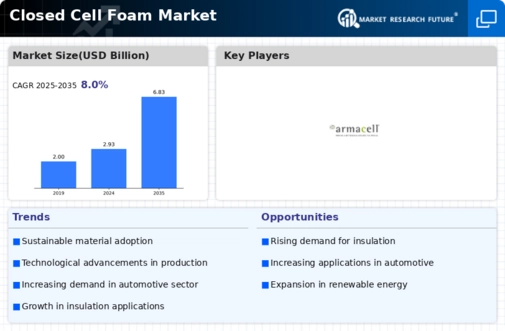By region, the study provides market insights into North America, Europe, Asia-Pacific, and Rest of the World. The anticipated expansion of the Closed Cell Foam market in North America can be attributed to several key factors. The aerospace sector, a prominent industry in North America, incorporates closed-cell foam for diverse applications, such as insulation and safeguarding components. Notably, the US witnessed a nearly 2.9% rise in military expenditure, reaching USD 801 billion in the past year, up from USD 778.23 billion. This maintained the United States' position as the leading global military spender, constituting 38% of the overall expenditure.
The expanding aerospace industry significantly fuels the demand for closed-cell foam products, reinforcing its relevance and adoption in the market.
Further, the major countries studied in the market report are the US, Canada, Germany, France, the UK, Italy, Spain, China, Japan, India, Australia, South Korea, and Brazil.
Figure 2: CLOSED CELL FOAM MARKET SHARE BY REGION 2023 (USD Billion)

Source: Secondary Research, Primary Research, Market Research Future Database and Analyst Review
Europe's cell Foam Market accounts for the second-largest market share as The European construction industry, prioritizing energy efficiency and sustainable construction practices, is driving the demand for insulation materials, notably closed-cell foam. In October 2022, there was a noteworthy increase of 1.3% in seasonally adjusted production within the construction sector, both in the euro area and the EU, compared to the preceding month. September 2022 saw a rise of 0.5% in the euro area and 0.3% in the EU.
Closed-cell foam's thermal properties and moisture resistance make it a preferred choice for insulation in construction projects, contributing to its widespread adoption in the industry. Further, the German Closed Cell Foam Market held the largest market share, and the UK Closed Cell Foam Market was the fastest-growing market in the European region
The Asia-Pacific Closed Cell Foam Market is expected to grow at the fastest CAGR from 2023 to 2032. The burgeoning construction industry in the Asia-Pacific region, fueled by rapid urbanization and infrastructure development projects, presents significant opportunities. With an anticipated 600 million people residing in urban centers by 2030, there is a demand for an additional 25 million mid-end and affordable housing units.
Notably, in India, the National Infrastructure Pipeline (NIP) allocates a substantial investment budget of $1.4 trillion, distributed across key sectors such as 24% in renewable energy, 18% in roads and highways, 17% in urban infrastructure, and 12% in railways. Closed-cell foam, valued for its thermal insulation properties, is increasingly embraced in construction applications, aligning with the industry's focus on energy efficiency and sustainability. Moreover, China’s Closed Cell Foam Market held the largest market share, and the Indian Closed Cell Foam Market was the fastest-growing market in the Asia-Pacific region.



